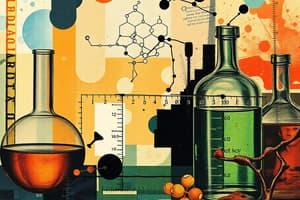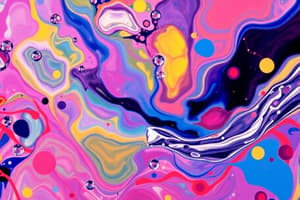Podcast
Questions and Answers
Which of the following factors does NOT influence the percentage of water in the human body?
Which of the following factors does NOT influence the percentage of water in the human body?
- Height (correct)
- Fat content
- Gender
- Age
Why is water considered an ideal biological solvent?
Why is water considered an ideal biological solvent?
- It is unable to transport molecules and heat.
- It doesn't affect molecular interactions.
- It only solubilizes hydrophobic molecules.
- It can dissolve most biological molecules, including proteins, nucleic acids, and carbohydrates because of its polarity. (correct)
Which property of water is essential for regulating body temperature?
Which property of water is essential for regulating body temperature?
- Its capacity for transporting molecules and heat (correct)
- Its fixed hydrogen ion content
- Its role as a reactant in metabolic reactions
- Its ability to dissolve nonpolar substances
What is the primary reason the body tightly controls both hydrogen ion concentration and the amount of body water?
What is the primary reason the body tightly controls both hydrogen ion concentration and the amount of body water?
What is a potential consequence of significant deviations from the body's constant environment?
What is a potential consequence of significant deviations from the body's constant environment?
What type of bond holds hydrogen and oxygen atoms together within a single water molecule?
What type of bond holds hydrogen and oxygen atoms together within a single water molecule?
What accounts for the polarity of a water molecule?
What accounts for the polarity of a water molecule?
How does water interact with polar molecules?
How does water interact with polar molecules?
According to the Brønsted-Lowry definition, what characterizes an acid?
According to the Brønsted-Lowry definition, what characterizes an acid?
What is the purpose of using the pH scale?
What is the purpose of using the pH scale?
What is the approximate pH inside human cells?
What is the approximate pH inside human cells?
What is the normal pH range of blood in the human body?
What is the normal pH range of blood in the human body?
What does the Henderson-Hasselbalch equation describe?
What does the Henderson-Hasselbalch equation describe?
Which of the following best describes the function of a buffer solution?
Which of the following best describes the function of a buffer solution?
What is the composition of a buffer solution?
What is the composition of a buffer solution?
How do buffers help maintain pH stability in a solution?
How do buffers help maintain pH stability in a solution?
What two factors determine the effectiveness of a buffer, also known as its buffer capacity?
What two factors determine the effectiveness of a buffer, also known as its buffer capacity?
Under what condition does a buffer have its maximum buffering capacity?
Under what condition does a buffer have its maximum buffering capacity?
Why is maintaining acid/base balance a major concern in clinical practice?
Why is maintaining acid/base balance a major concern in clinical practice?
What would be a serious consequence of blood pH falling below 7.0 or rising above 7.8?
What would be a serious consequence of blood pH falling below 7.0 or rising above 7.8?
Which of the following statements best describes the typical concentration of water in the human body?
Which of the following statements best describes the typical concentration of water in the human body?
What is the approximate angle between the hydrogen atoms and the oxygen atom in a water molecule?
What is the approximate angle between the hydrogen atoms and the oxygen atom in a water molecule?
Which of the following is true regarding the distribution of water in the body?
Which of the following is true regarding the distribution of water in the body?
If a solution has a pH of 3, how would you describe it?
If a solution has a pH of 3, how would you describe it?
If the concentration of H+ ions in a solution increases, what happens to the pH?
If the concentration of H+ ions in a solution increases, what happens to the pH?
Which of the following pH values is considered neutral?
Which of the following pH values is considered neutral?
Which of the following is an example of a bodily fluid with a slightly basic pH?
Which of the following is an example of a bodily fluid with a slightly basic pH?
How does water's polarity affect its ability to dissolve salts, like NaCl?
How does water's polarity affect its ability to dissolve salts, like NaCl?
If a buffer solution contains equal concentrations of a weak acid and its conjugate base, what is the relationship between the pH of the solution and the pKa of the acid?
If a buffer solution contains equal concentrations of a weak acid and its conjugate base, what is the relationship between the pH of the solution and the pKa of the acid?
How does water contribute as a product of oxidative metabolism?
How does water contribute as a product of oxidative metabolism?
Which of the following is a role for water in many metabolic reactions?
Which of the following is a role for water in many metabolic reactions?
Consider a scenario where significant dehydration occurs in the body. Which of the following scenarios are LIKELY to take place?
Consider a scenario where significant dehydration occurs in the body. Which of the following scenarios are LIKELY to take place?
Flashcards
Body water content
Body water content
Approximately 60% of human body weight.
Intracellular fluid
Intracellular fluid
2/3 of total body water is located inside cells.
Extracellular fluid
Extracellular fluid
1/3 of total body water is located outside cells.
Factors affecting body water
Factors affecting body water
Signup and view all the flashcards
Water as a solvent
Water as a solvent
Signup and view all the flashcards
Water's other functions
Water's other functions
Signup and view all the flashcards
Homeostasis
Homeostasis
Signup and view all the flashcards
Life threatening deviations
Life threatening deviations
Signup and view all the flashcards
Water molecule structure
Water molecule structure
Signup and view all the flashcards
Water's polarity
Water's polarity
Signup and view all the flashcards
Water's dipole nature
Water's dipole nature
Signup and view all the flashcards
Acid (Brønsted-Lowry)
Acid (Brønsted-Lowry)
Signup and view all the flashcards
Base (Brønsted-Lowry)
Base (Brønsted-Lowry)
Signup and view all the flashcards
Strong electrolytes
Strong electrolytes
Signup and view all the flashcards
Weak electrolytes
Weak electrolytes
Signup and view all the flashcards
Autoionization of Water
Autoionization of Water
Signup and view all the flashcards
Ion product for water (Kw)
Ion product for water (Kw)
Signup and view all the flashcards
pH
pH
Signup and view all the flashcards
Buffer solution
Buffer solution
Signup and view all the flashcards
Buffer composition
Buffer composition
Signup and view all the flashcards
Buffer action
Buffer action
Signup and view all the flashcards
Factors affecting buffer capacity
Factors affecting buffer capacity
Signup and view all the flashcards
Maximum buffering capacity
Maximum buffering capacity
Signup and view all the flashcards
H+ concentration
H+ concentration
Signup and view all the flashcards
Study Notes
- Biochemistry Lecture 2 covers water, pH, and buffers.
Body Content of Water
- Approximately 60% of human body weight is water.
- 2/3 of body water is intracellular fluid.
- 1/3 of body water is extracellular fluid.
- The percentage of water in the body varies with age (decreases), fat content (decreases), and gender (males have more body water than females).
Functions of Water in the Human Body
- Water is an ideal biological solvent.
- Water solubilizes proteins, nucleic acids, and carbohydrates.
- Interaction with water influences the structure of biomolecules.
- Water modifies the properties of molecules in biological systems.
- Water is important for the transport of molecules and heat.
- Water is a product of oxidative metabolism of food.
- Water is a reactant in many metabolic reactions.
- The hydrogen ion content and the amount of body water are controlled to maintain a constant environment for the cells called homeostasis.
- Significant deviations from a constant environment, such as acidosis or dehydration, may be life-threatening.
Structure of a Water Molecule
- A water molecule consists of two hydrogen atoms bonded to an oxygen atom by a covalent bond.
- The angle between the H atom and O atom is 105°.
- A water molecule is a slightly skewed tetrahedron with oxygen at its center.
Polarity of Water
- The water molecule is polar.
- The oxygen atom is more electronegative than the hydrogen atoms, resulting in an asymmetry in the distribution of charge.
- Water solvates polar molecules due to H-bond interactions.
- Water weakens H-bonds and electrostatic bonds between polar molecules.
Acids and Bases
- According to Brønsted-Lowry, an acid is a proton donor, and a base is a proton acceptor.
- HA + H₂O ⇌ H₃O⁺ + A⁻ represents a conjugate acid-base pair, where HA is the acid and A⁻ is its conjugate base.
- HA + H₃N: ⇌ NH₄⁺+ A⁻ represents a conjugate acid-base pair.
Strong and Weak Electrolytes
- Strong electrolytes ionize completely in solution, like HCl → H⁺ + Cl⁻.
- Weak electrolytes ionize only partially, like CH₃COOH + H₂O ⇌ CH₃COO⁻ + H⁺.
Ion Product for Water (Kw)
- Water is an extremely weak electrolyte that undergoes autoionization.
- Autoionization forms very small, but equal, amounts of hydronium and hydroxide ions.
- The equation for autoionization is: H₂O(L) + H₂O(L) ⇌ H₃O⁺(aq) + OH⁻(aq).
- K = [H+][OH-]/[H₂O]² or K[H₂O]² = [H+][OH⁻].
- The concentration of H₂O is very high (55.5M) relative to that of [H⁺] and [OH⁻].
- K = [H+][OH⁻] = 1.0 x 10⁻¹⁴ M² at 25°C.
- The term (K) is referred to as the ion product of water.
pH
- To express very low values of [H⁺] in biological systems, the concept of pH was introduced by Sorensen.
- pH is the negative log₁₀ of hydrogen ion concentration: pH = -log₁₀[H⁺].
- Example: The pH of 0.001 M HCl is 3.
- The pH scale ranges from very acidic to very basic.
- The physiological pH must remain nearly constant in the human body.
- pH inside cells is approximately 7.
- pH in blood is approximately 7.4 ± 0.05.
Henderson-Hasselbalch Equation
- The Henderson-Hasselbalch equation describes the behavior of weak acids and buffers.
- Weak acids and bases in solution do not fully dissociate.
- There is an equilibrium between the acid and its conjugate base.
- The equilibrium constant for it (Kₐ) can be calculated.
- In the reaction of a weak acid: HA ⇌ A⁻ + H⁺.
- Kₐ= [H+][A⁻]/[HA].
- For the weak acid HA and its salt A: HA ⇌ H⁺ + A⁻.
- The equilibrium dissociation constant for a weak acid is: Kₐ = [H+][A⁻]/[HA].
- The Henderson Hasselbalch equation is pH = pKₐ + log[A⁻]/[HA].
Buffers
- A buffer solution resists changes in pH upon the addition of acid or base.
- A buffer consists of a mixture of a weak acid and its conjugate base (e.g., CH₃COOH/CH₃COO⁻) or a weak base and its conjugate acid (e.g., NH₃/NH₄⁺).
- Buffers accept hydrogen ions from the solution when they are in excess and donate hydrogen ions when they have been depleted.
- H₂CO₃ ⇌ H⁺ + HCO₃⁻ is an example of a buffering system.
- The effectiveness of a buffer, called buffer capacity, depends on two factors: the concentration of buffering agents and the ratio of the weak acid to its conjugate base.
- The maximum buffering capacity at a ratio of one: pH = pKₐ.
Physiological Buffers
- Acid/base balance is one of the major problems in clinical practice.
- H⁺ concentration in plasma and extracellular fluid is 40 nmol/L, i.e., pH 7.4.
- The normal pH range is 7.35-7.45.
- A pH below 7.0 or above 7.8 can have serious consequences.
Studying That Suits You
Use AI to generate personalized quizzes and flashcards to suit your learning preferences.




